How I Do It by Rachael Langley – PODD in the Classroom: Portable, Wearable, & Comfortable
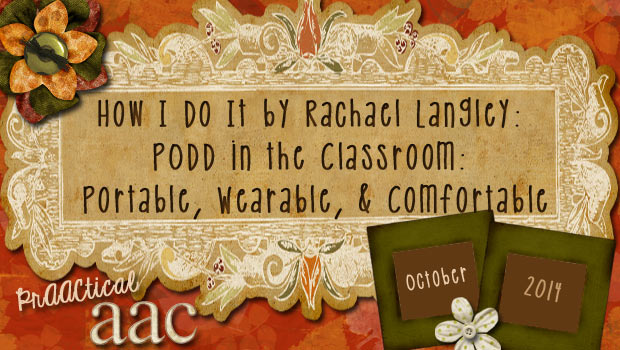
 We return to Michigan today to hear more from school-based SLP, Rachael Langley. In this post, Rachael shares some prAACtical thoughts on making PODD books always available for communication.
We return to Michigan today to hear more from school-based SLP, Rachael Langley. In this post, Rachael shares some prAACtical thoughts on making PODD books always available for communication.
:::::::::::::::::::::::::::::::::::::::::::::::::::::::::::::::::::::::::
The PODD system offers a complete language approach through carefully organized symbol sets. Because the PODD system promotes a language immersion model, there is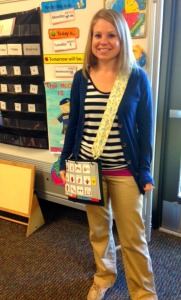 no pressure on our language-learners reproducing specific words or patterns at a specific rate. The primary requirement is that adults are modeling PODD for our language-learners.
no pressure on our language-learners reproducing specific words or patterns at a specific rate. The primary requirement is that adults are modeling PODD for our language-learners.
In order to be sure that the PODD books were being used throughout the day, the books had to be PORTABLE, WEARABLE, and COMFORTABLE. Forget any of these three features and PODD books are at a high risk of being stuck on a shelf. My new hobby has become collecting other people’s ideas for how to make PODD books comfortable to carry around. I’ll spare you the pictures of my failed attempts, but suffice it to say that PVC and fabric was involved. I’ve seen these materials used successfully before, but my end-product was pretty pitiful.
Here’s my newest method for making PODD books portable, wearable, and comfortable – it the best I’ve come up with so far:
- Use a Mead Flex binder to hold the PODD
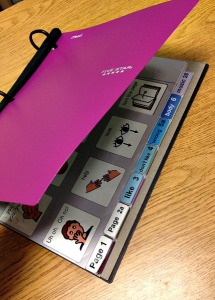
We have our PODD books printed on a waterproof, tear-proof paper. However you decide print the pages, use a standard three-ring punch and place them in these great binders from Mead. They’re lightweight but offer stability with a firm backing. The binding edge is protected with a nylon fabric covering. Even the “rings” that go through the holes are rubber, which adds to the flexibility and softer feel. All of these features are important because, if you plan on wearing the PODD in the classroom, it will likely bump into people (including you) throughout the day and those sharp edges make it uncomfortable. I found this flexible binder at Staples for around $10-12, but I’ve since seen it at lots of other stores.
2. Attach Binder to a Comfortable Carrying Strap 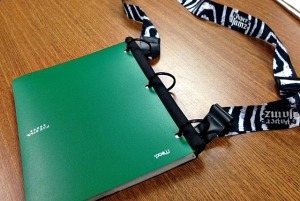
While PODD books can be used without a carrying strap, this greatly increases the likelihood that A) the PODD will be left on a table or shelf somewhere and B) you will miss teachable moments because the book is just out of reach. By adding a carrying strap, your hands are free to do the 15 other things we do in the classroom, but the PODD is still with you.
There are several options for carrying strap, including:
- strap from a laptop bag
- luggage strap
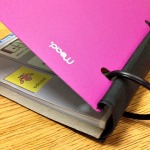
- adjustable camera strap
- custom fabric strap with button holes as reinforcers at the ends
Whatever your method for carrying the book, the key is that it is comfortable. Without the comfort of a little padding, I had feedback from staff like, “It’s too heavy,” “It hurts my neck,” and the PODD books end up right back on a shelf. I’ve found that portability, wearability, and comfort are equally important.
After your PODD books are assembled and comfortable, go show the teams how they are used. I have found it is so important not just to observe, but to join in the modeling. This is a new language system and it can be intimidating to get started. Modeling in the classroom reminds everyone that we can “talk PODD” anytime.
:::::::::::::::::::::::::::::::::::::::::::::::::::::::::::::::::::::::
Filed under: PrAACtical Thinking
Tagged With: PODD, Rachael Langley
This post was written by Carole Zangari
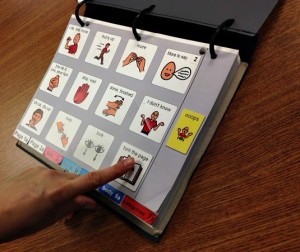
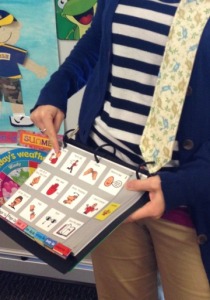

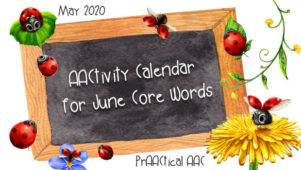

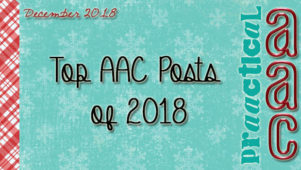
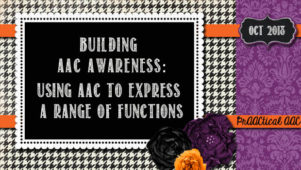
11 Comments
Thank you for the information on creating podd books! I was wondering if you print your podd books in your district or if you get them printed by a printing company. We have purchased the podd software and are preparing to produce the books. My district purchased synthetic paper to print the books on. I would love to hear how other districts have published their books and what method is the most cost and labor effective. Thanks again!
Hi Linda!
Sorry for the late reply. We do not have the printing process down to a science in my home district. For regular printing, we work with our local mom ‘n pop printer. For these 1-page opening books, we used another school district’s printing services. They produced some books for us for a fee. They have the process down! I believe they use igage paper (see link below).
We typically have the 2-page opening books finished with comb-binding. It is a bit labor intensive to prep the files for printing, assemble a book, and then carefully cut away the excess paper on each page to leave the tabs for easy navigation. But the igage paper makes these books DURABLE. There’s potential to have these books produced at the state level through a state-wide resource for AT/educational supports… but that is still in development. I’d encourage you to talk to your state organization and see if you can gather some other professionals using PODD to encourage a centralized production. PODD has become a great tool for communication/language support and the word is spreading!
Good luck to you!
Rachael
http://www.igage.com/mp/wpp/igage_weatherproof_paper.htm#_letter
Hello,
I just found this site and I like what I see. I must admit I became overwhelmed with all the information. I would like to use visuals more in my classroom. I work with preschoolers and it is a struggle to get a system going. Any suggestions on where to start. I have 8 non verbal students and 1 Aid. We have been trolling the internet looking for resources so any feedback would be wonderful.
This is a really great idea! I hope to make something like this for my AAC kids to be able to take home with them.
As a former music teacher turned SPED teacher thought immediatly of using a guitar strap or a saxophone strap. They are padded and made to hold something heavy while keeping you comfortable.
Is it just me or do the pages get caught on the binder rings, and don’t turn smoothly. I was hoping to use this so I could change out pages easily, am I missing something or have they maybe changed the notebook since original post.
Vivienne, no it is not just you, I bought the same notebinder but I can’t punch the holes big enough to make them turn smoothly? Any ideas?
I’ve been dealing with the same thing. We’re just getting started and my daughter ends up stimming on the spiral bound books, so we decided to buy this binder. It’s been working ok, but it’s not easy to turn and also, we have had a couple of instances of the “ring” popping open. At school, they’re trying to teach her to carry her own book and I worry it will just get more likely to pop open.
I’ve been thinking we may just use regular metal O-rings, but I’m trying to figure out how we can protect the book by having a cover of some sort. I may go buy some binding covers or just cut up a plastic folder. I’d love any advice.
How many pages is this PODD book1/
Hi! Do you have the dimensions for the fabric straps you create? We use PECS for our therapy center with kiddos with ASD and are having trouble finding the appropriate book straps. THis would be amazing to make for the books as a strap instead!
Best,
I love this idea, but my problem is how to teach these kids to refer to the PECs while they are upset or defiant???